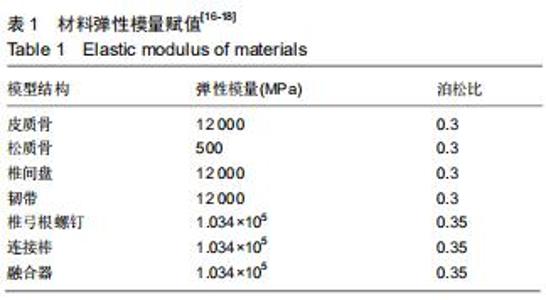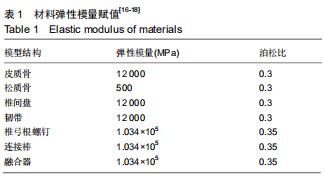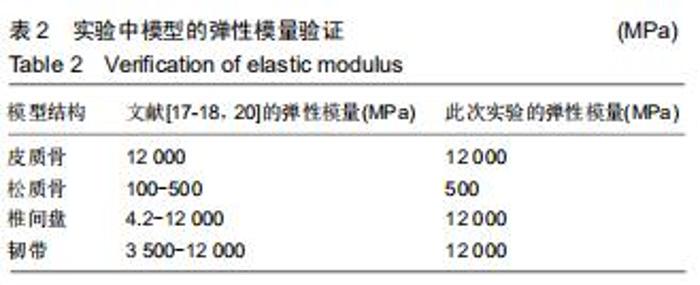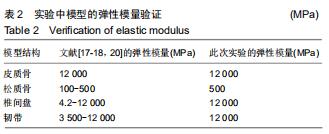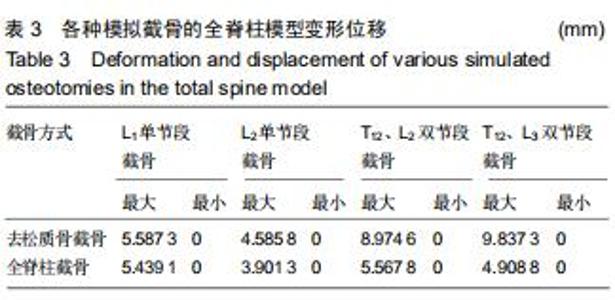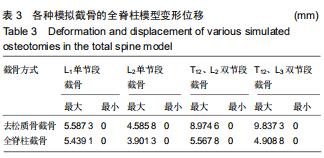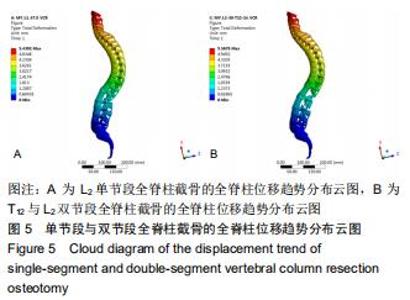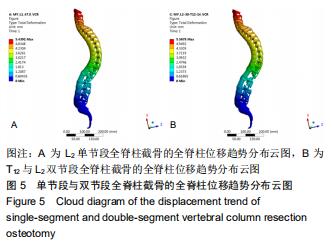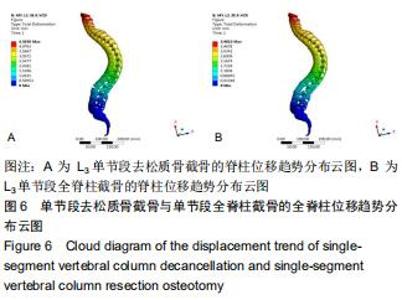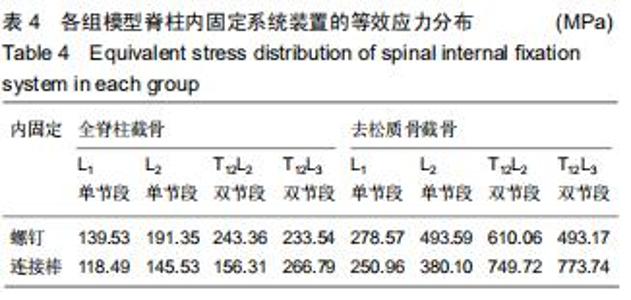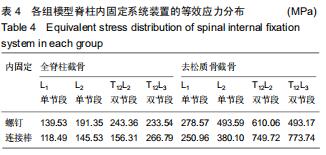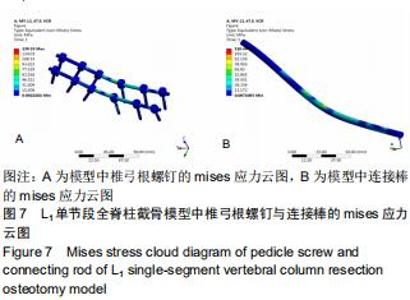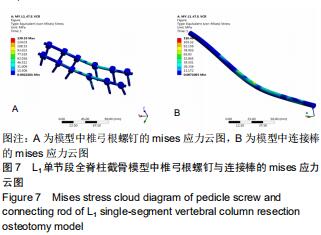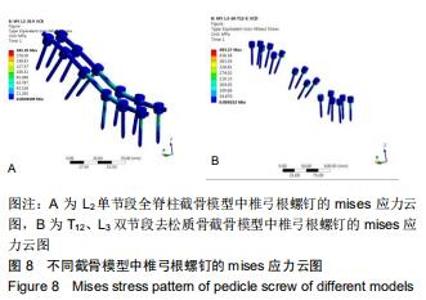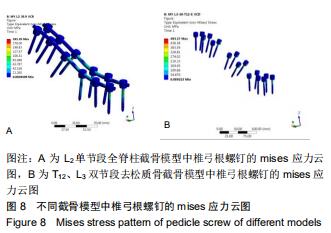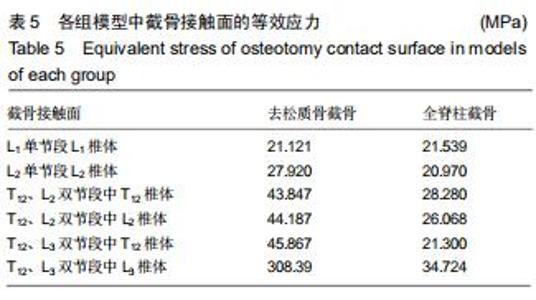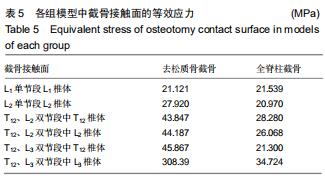Chinese Journal of Tissue Engineering Research ›› 2020, Vol. 24 ›› Issue (27): 4285-4290.doi: 10.3969/j.issn.2095-4344.2792
Previous Articles Next Articles
Finite element analysis of double-segment and single-segment vertebral column decancellation and vertebral column resection osteotomy for ankylotic kyphosis
Duan Yanji1, Chen Xiao1, Zhou Yongqiang1, Huang Kai1, Shen Donglan1, Ma Yuan2
1Department of Orthopedics, First People’s Hospital of Neijiang, Neijiang 641000, Sichuan Province, China; 2Department of Spine Surgery, Sixth Affiliated Hospital of Xinjiang Medical University, Urumqi 813002, Xinjiang Uygur Autonomous Region, China
-
Received:2019-12-20Revised:2019-12-25Accepted:2020-02-14Online:2020-09-28Published:2020-09-05 -
Contact:Ma Yuan, Associate professor, Doctoral supervisor, Department of Spine Surgery, Sixth Affiliated Hospital of Xinjiang Medical University, Urumqi 813002, Xinjiang Uygur Autonomous Region, China -
About author:Duan Yanji, Master, Physician, Department of Orthopedics, First People’s Hospital of Neijiang, Neijiang 641000, Sichuan Province, China -
Supported by:the National Natural Science Foundation of China, No. 81360280
CLC Number:
Cite this article
Duan Yanji, Chen Xiao, Zhou Yongqiang, Huang Kai, Shen Donglan, Ma Yuan.
Finite element analysis of double-segment and single-segment vertebral column decancellation and vertebral column resection osteotomy for ankylotic kyphosis [J]. Chinese Journal of Tissue Engineering Research, 2020, 24(27): 4285-4290.
share this article
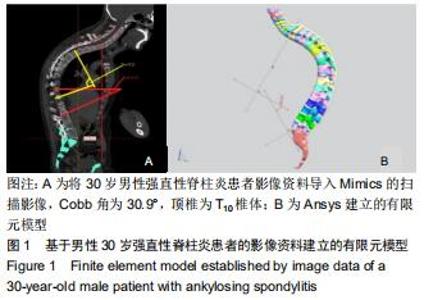
1.4.1 初步重建三维模型 该患者进行全脊柱CT扫描,CT采用TOSHIBA/Aquilion ONE 320排CT行扫描,扫描间隔1 mm,像素分辨率为512×512,层厚0.5 mm,共获取CT二维图像2 434张,以DICOM格式保存。将所得图像导入三维医学重建软件Mimics中,得到初步三维立体模型(图1A)。由于初步建立的三维模型不利于有限元分析软件的计算,采用Geomagic studio 2013对该模型进行三维修补和填充,修饰和优化一些孔洞和缺陷、不规则的边界,以改善四面体单元的模型质量。最后利用UG NX8.5模拟脊柱矫形术式,包括添加椎弓根螺钉和固定棒等后路内固定系统,模拟载荷平面,采用曲线和草图性能,同时构建连接椎体之间的僵化韧带模型。 1.4.2 建立三维有限元模型 将修饰后的截骨脊柱模型导入Ansys 15.0有限元分析软件,对模型中的皮质骨、松质骨、椎间盘、韧带、椎弓根螺钉、固定棒、Synmesh融合器等的弹性模量、泊松比进行赋值,采用尽量接近实体的全脊柱僵化韧带模型参数[15],见表1。建立强直性脊柱后凸的三维有限元模型,为了保证模型的精准度,采用四面体接触,共955 608个单元,1 554 431个节点(图1B)。 "
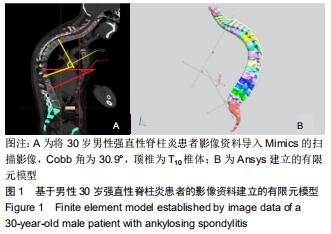
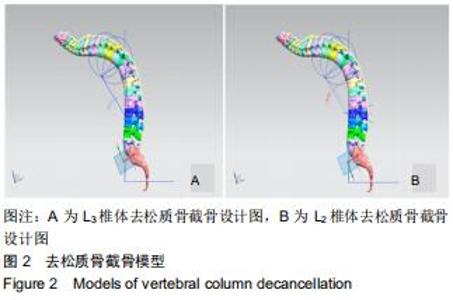
截骨方式:截骨角度采用肺门-髋轴法,对矢状面平衡及截骨角度进行计算,参考SONG等[1]利用肺门和髋轴入射角之间的平衡关系,使截骨角度更加接近真实人体生物力学平衡点(图2,Ansys中的L2,3椎体单节段的去松质骨截骨截骨设计图)。截骨方式分别为全脊柱截骨与去松质骨截骨[19],截骨模型简称分为去松质骨截骨模型与全脊柱截骨模型,分为双节段与单节段截骨,截骨节段分别是,对L1和L2椎体行单节段截骨,对T12、L2和T12、L3椎体行双节段截骨,即L1单节段全脊柱截骨模型、L1单节段去松质骨截骨模型、L2单节段全脊柱截骨模型、L2单节段去松质骨截骨模型、T12L2双节段全脊柱截骨模型、T12L2双节段去松质骨截骨模型、T12L3双节段全脊柱截骨模型、T12L3双节段去松质骨截骨模型8组。 "
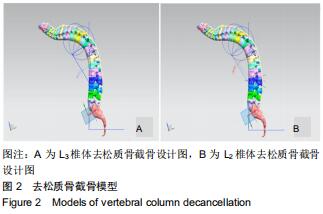
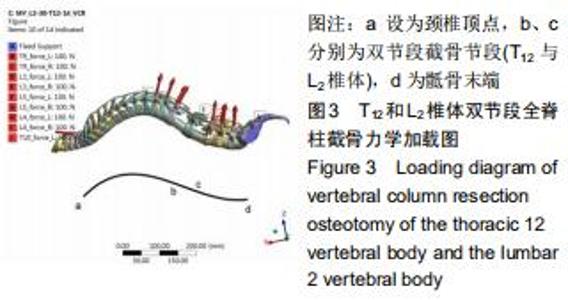
截骨模型与加载:强直性脊柱炎常常伴随关节及韧带的纤维骨化和滑膜增厚。在实验过程中为了更加接近实体模型,以T12和L2椎体双节段全脊柱截骨模型(图3)为例说明,设颈椎顶点为a,T12与L2椎体截骨面后方位置处为b、c点(如模型为单节段截骨则标记为一点,如图4),骶骨前端为d。将脊柱想象为有一定抗弯刚度的曲杆,在加载过程中使截骨椎体产生一定曲度,使模型中的螺钉随着截骨上端运动。运动中由于不再接受垂直力的约束,其受到垂直的反力会更小。但由于截骨模型简化为铰支座,不传递弯矩,只会传递轴力,将发生轴向变形,几乎无侧向(垂直脊柱方向)运动。根据受力平衡条件,随着钛棒穿过螺钉两端的夹角改变,螺钉受到的拔力将向上,见图3,4。 "
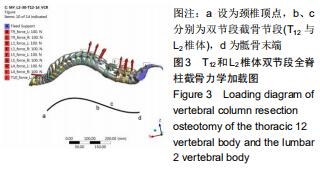
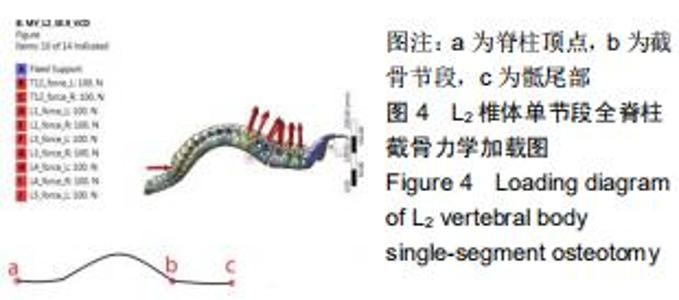
截骨模型与加载:强直性脊柱炎常常伴随关节及韧带的纤维骨化和滑膜增厚。在实验过程中为了更加接近实体模型,以T12和L2椎体双节段全脊柱截骨模型(图3)为例说明,设颈椎顶点为a,T12与L2椎体截骨面后方位置处为b、c点(如模型为单节段截骨则标记为一点,如图4),骶骨前端为d。将脊柱想象为有一定抗弯刚度的曲杆,在加载过程中使截骨椎体产生一定曲度,使模型中的螺钉随着截骨上端运动。运动中由于不再接受垂直力的约束,其受到垂直的反力会更小。但由于截骨模型简化为铰支座,不传递弯矩,只会传递轴力,将发生轴向变形,几乎无侧向(垂直脊柱方向)运动。根据受力平衡条件,随着钛棒穿过螺钉两端的夹角改变,螺钉受到的拔力将向上,见图3,4。"
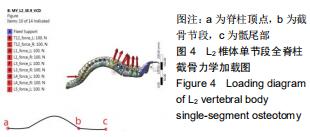
|
[1] SONG K, ZHENG G, ZHANG Y, et al. A new method for calculating the exact angle required for spinal osteotomy. Spine(Phila Pa 1976).2013;38(10):E616-E620.
[2] WEI Y, ZOU Z, WEI G, et al. Subject-Specific Finite Element Modelling of the Human Hand Complex: Muscle-Driven Simulations and Experimental Validation.Ann Biomed Eng.2019.doi: 10.1007/s10439-019-02439-2.[Epub ahead of print]
[3] ANITHA DP, BAUM T, KIRSCHKE JS, et al. Effect of the intervertebral disc on vertebral bone strength prediction: a Finite-Element study.Spine J.2019.pii: S1529-9430(19)31116-7.
[4] CHANDRA Y, MUKHOPADHYAY T, ADHIKARI S, et al. Size-dependent dynamic characteristics of graphene based multi-layer nano hetero-structures. Nanotechnology. 2020; 31(14):145705.
[5] SAEED M, WEIHS D. Finite element analysis reveals an important role for cell morphology in response to mechanical compression.Biomech Model Mechanobiol.2019.doi: 10.1007/s10237-019-01276-5.[Epub ahead of print]
[6] XIE YM, ZHENG YC, QIU SJ, et al. The appropriate hybrid surgical strategy in three-level cervical degenerative disc disease: a finite element analysis.J Orthop Surg Res.2019;14(1):444.
[7] 段延辑,马俊毅,李辉,等.有限元法分析强直性脊柱后凸去松质骨截骨与全脊椎截骨矫形的生物力学特点[J].中国组织工程研究, 2017, 21(31):5019-5024.
[8] KAWAMURA J, PARK JH, KOJIMA Y, et al. Biomechanical analysis for total mesialization of the mandibular dentition : A finite element study.Orthod Craniofac Res.2019;22(4):329-336.
[9] KRÓL R, SIEMIĄ TKOWSKI Z. The analysis of shrink-fit connection - the methods of heating and the factors influencing the distribution of residual stresses.Heliyon.2019;5(11):e02839.
[10] OKAMOTO Y, MURAKAMI H, DEMURA S, et al. The effect of kyphotic deformity because of vertebral fracture: a finite element analysis of a 10° and 20° wedge-shaped vertebral fracture model. Spine J. 2015;15(4):713-720.
[11] LIU Z, HUANG F, LUO G, et al. miR-214 stimulated by IL-17A regulates bone loss in patients with ankylosing spondylitis. Rheumatology (Oxford).2019.pii: kez594.
[12] KANERVA M, PÄRNÄNEN T, JOKINEN J, et al. Multi-axis fatigue experimentation system of intramedullary implants for femur and tibia.J Orthop Res.2019.doi: 10.1002/jor.24545. [Epub ahead of print]
[13] TRIBST JPM, DAL PIVA AMO, BORGES ALS, et al. Effect of different materials and undercut on the removal force and stress distribution in circumferential clasps during direct retainer action in removable partial dentures.Dent Mater.2020;36(2):179-186.
[14] 郑国权,张永刚,王岩,等.强直性脊柱炎后凸畸形的301分型[J].中国脊柱脊髓杂志,2015,25(9):769-774.
[15] MARTINDALE J, SHUKLA R, GOODACRE J. The impact of ankylosing spondylitis/axial spondyloarthritis on work productivity. Best Pract Res Clin Rheumatol.2015;29(3):512-523.
[16] WANG JL, PARNIANPOUR M, SHIRAZI- ADL A, et al. Viscoelastic finite-element analysis of a lumbar motion segment in combined compression and sagittal flexion.Spine (Phila Pa 1976). 2000;25(3):310-318.
[17] BURSTEIN AH, REILLY DT, MARTENS M. Aging of bone tissue: mechanical properties.J Bone Joint Surg Am.1976;58(1):82-86.
[18] SHIRAZI-ADL SA, SHRIVASTAVA SC, AHMED AM. Stress Analysis of the Lumbar Disc-Body Unit in Compression A Three-Dimensional Nonlinear Finite Element Study.Spine(Phila Pa 1976). 1984;9(2):120-134.
[19] ZHANG X, ZHANG Z, WANG J, et al. Vertebral column decancellation: a new spinal osteotomy technique for correcting rigid thoracolumbar kyphosis in patients with ankylosing spondylitis. Bone Joint J. 2016;98-B(5):672-678.
[20] LEFÈVRE E, FARLAY D, BALA Y, et al. Compositional and mechanical properties of growing cortical bone tissue: a study of the human fibula.Sci Rep.2019;9(1):17629.
[21] JAYENDIRAN R, NOUR B, RUIMI A. Computational analysis of Nitinol stent-graft for endovascular aortic repair (EVAR) of abdominal aortic aneurysm (AAA): Crimping, sealing and fluid-structure interaction (FSI). Int J Cardiol. 2020;304:164-171.
[22] PRASADH S, SURESH S, HONG KL, et al. Biomechanics of alloplastic mandible reconstruction using biomaterials: The effect of implant design on stress concentration influences choice of material.J Mech Behav Biomed Mater.2020;103:103548.
[23] CHEN H, ZHU ZG, LI JT, et al. Finite element analysis of an intramedulary anatomical strut for proximal humeral fractures with disrupted medial column instability: A cohort study.Int J Surg. 2020;73:50-56.
[24] ZHOU J, SHE X, MILLER PD, et al. Selective osteotomy-assisted molar uprighting and simultaneous ridge augmentation for implant site development.Am J Orthod Dentofacial Orthop.2019;156(6): 846-857.
[25] MATSUZAKI T, AYUKAWA Y, MATSUSHITA Y, et al. Effect of post-osseointegration loading magnitude on the dynamics of peri-implant bone: a finite element analysis and in vivo study.J Prosthodont Res.2019;63(4):453-459.
[26] WANG T, CAI Z, ZHAO Y, et al. The Influence of Cross-Links on Long-Segment Instrumentation Following Spinal Osteotomy: A Finite Element Analysis.World Neurosurg.2019;123:e294-e302.
[27] INANMAZ ME, KOSE KC, ATMACA H, et al. Using a Combination of Intralaminar and Pedicular Screw Constructs for Enhancement of Spinal Stability and Maintenance of Correction in Patients With Sagittal Imbalance: Clinical Applications and Finite Element Analysis. Clin Spine Surg. 2016;29(8):E421-427.
[28] LIANG Y, TANG X, ZHAO Y, et al. Posterior wedge osteotomy and debridement for Andersson lesion with severe kyphosis in ankylosing spondylitis.J Orthop Surg Res.2017;12(1):54.
[29] HU W, WANG B, RUN H, et al. Pedicle subtraction osteotomy and disc resection with cage placement in post-traumatic thoracolumbar kyphosis, a retrospective study.J Orthop Surg Res. 2016;11(1):112.
[30] MUHEREMU A, LI H, MA J, et al. Establishment of a three-dimensional finite element model of severe kyphotic deformity secondary to ankylosing spondylitis.J Int Med Res. 2017;45(2):639-646.
[31] BESS S, HARRIS JE, TURNER AW, et al. The effect of posterior polyester tethers on the biomechanics of proximal junctional kyphosis: a finite element analysis.J Neurosurg Spine. 2017; 26(1):125-133. |
| [1] | Hu Kai, Qiao Xiaohong, Zhang Yonghong, Wang Dong, Qin Sihe. Treatment of displaced intra-articular calcaneal fractures with cannulated screws and plates: a meta-analysis of 15 randomized controlled trials [J]. Chinese Journal of Tissue Engineering Research, 2021, 25(9): 1465-1470. |
| [2] | Xu Feng, Kang Hui, Wei Tanjun, Xi Jintao. Biomechanical analysis of different fixation methods of pedicle screws for thoracolumbar fracture [J]. Chinese Journal of Tissue Engineering Research, 2021, 25(9): 1313-1317. |
| [3] | Zhang Tongtong, Wang Zhonghua, Wen Jie, Song Yuxin, Liu Lin. Application of three-dimensional printing model in surgical resection and reconstruction of cervical tumor [J]. Chinese Journal of Tissue Engineering Research, 2021, 25(9): 1335-1339. |
| [4] | Chen Xinmin, Li Wenbiao, Xiong Kaikai, Xiong Xiaoyan, Zheng Liqin, Li Musheng, Zheng Yongze, Lin Ziling. Type A3.3 femoral intertrochanteric fracture with augmented proximal femoral nail anti-rotation in the elderly: finite element analysis of the optimal amount of bone cement [J]. Chinese Journal of Tissue Engineering Research, 2021, 25(9): 1404-1409. |
| [5] | Du Xiupeng, Yang Zhaohui. Effect of degree of initial deformity of impacted femoral neck fractures under 65 years of age on femoral neck shortening [J]. Chinese Journal of Tissue Engineering Research, 2021, 25(9): 1410-1416. |
| [6] | Zhang Shangpu, Ju Xiaodong, Song Hengyi, Dong Zhi, Wang Chen, Sun Guodong. Arthroscopic suture bridge technique with suture anchor in the treatment of acromioclavicular dislocation [J]. Chinese Journal of Tissue Engineering Research, 2021, 25(9): 1417-1422. |
| [7] | Zhou Jihui, Li Xinzhi, Zhou You, Huang Wei, Chen Wenyao. Multiple problems in the selection of implants for patellar fracture [J]. Chinese Journal of Tissue Engineering Research, 2021, 25(9): 1440-1445. |
| [8] | Chen Junming, Yue Chen, He Peilin, Zhang Juntao, Sun Moyuan, Liu Youwen. Hip arthroplasty versus proximal femoral nail antirotation for intertrochanteric fractures in older adults: a meta-analysis [J]. Chinese Journal of Tissue Engineering Research, 2021, 25(9): 1452-1457. |
| [9] | Xu Yulin, Shen Shi, Zhuo Naiqiang, Yang Huilin, Yang Chao, Li Yang, Zhao Heng, Zhao Lu. Biomechanical comparison of three different plate fixation methods for acetabular posterior column fractures in standing and sitting positions [J]. Chinese Journal of Tissue Engineering Research, 2021, 25(6): 826-830. |
| [10] | Cai Qunbin, Zou Xia, Hu Jiantao, Chen Xinmin, Zheng Liqin, Huang Peizhen, Lin Ziling, Jiang Ziwei. Relationship between tip-apex distance and stability of intertrochanteric femoral fractures with proximal femoral anti-rotation nail: a finite element analysis [J]. Chinese Journal of Tissue Engineering Research, 2021, 25(6): 831-836. |
| [11] | Hou Guangyuan, Zhang Jixue, Zhang Zhijun, Meng Xianghui, Duan Wen, Gao Weilu. Bone cement pedicle screw fixation and fusion in the treatment of degenerative spinal disease with osteoporosis: one-year follow-up [J]. Chinese Journal of Tissue Engineering Research, 2021, 25(6): 878-883. |
| [12] | He Li, Tian Wei, Xu Song, Zhao Xiaoyu, Miao Jun, Jia Jian. Factors influencing the efficacy of lumbopelvic internal fixation in the treatment of traumatic spinopelvic dissociation [J]. Chinese Journal of Tissue Engineering Research, 2021, 25(6): 884-889. |
| [13] | Yang Weiqiang, Ding Tong, Yang Weike, Jiang Zhengang. Combined variable stress plate internal fixation affects changes of bone histiocyte function and bone mineral density at the fractured end of goat femur [J]. Chinese Journal of Tissue Engineering Research, 2021, 25(6): 890-894. |
| [14] | Zhang Lei, Ma Li, Fu Shijie, Zhou Xin, Yu Lin, Guo Xiaoguang. Arthroscopic treatment of greater tuberosity avulsion fractures with anterior shoulder dislocation using the double-row suture anchor technique [J]. Chinese Journal of Tissue Engineering Research, 2021, 25(6): 895-900. |
| [15] | Yuan Xinping, Shao Yanbo, Wu Chao, Wang Jianling, Tong Liangcheng, Li Ying. Accuracy of target bone segments in personalized differential modeling and simulation of CT scanning parameters at fracture end [J]. Chinese Journal of Tissue Engineering Research, 2021, 25(6): 912-916. |
| Viewed | ||||||
|
Full text |
|
|||||
|
Abstract |
|
|||||
